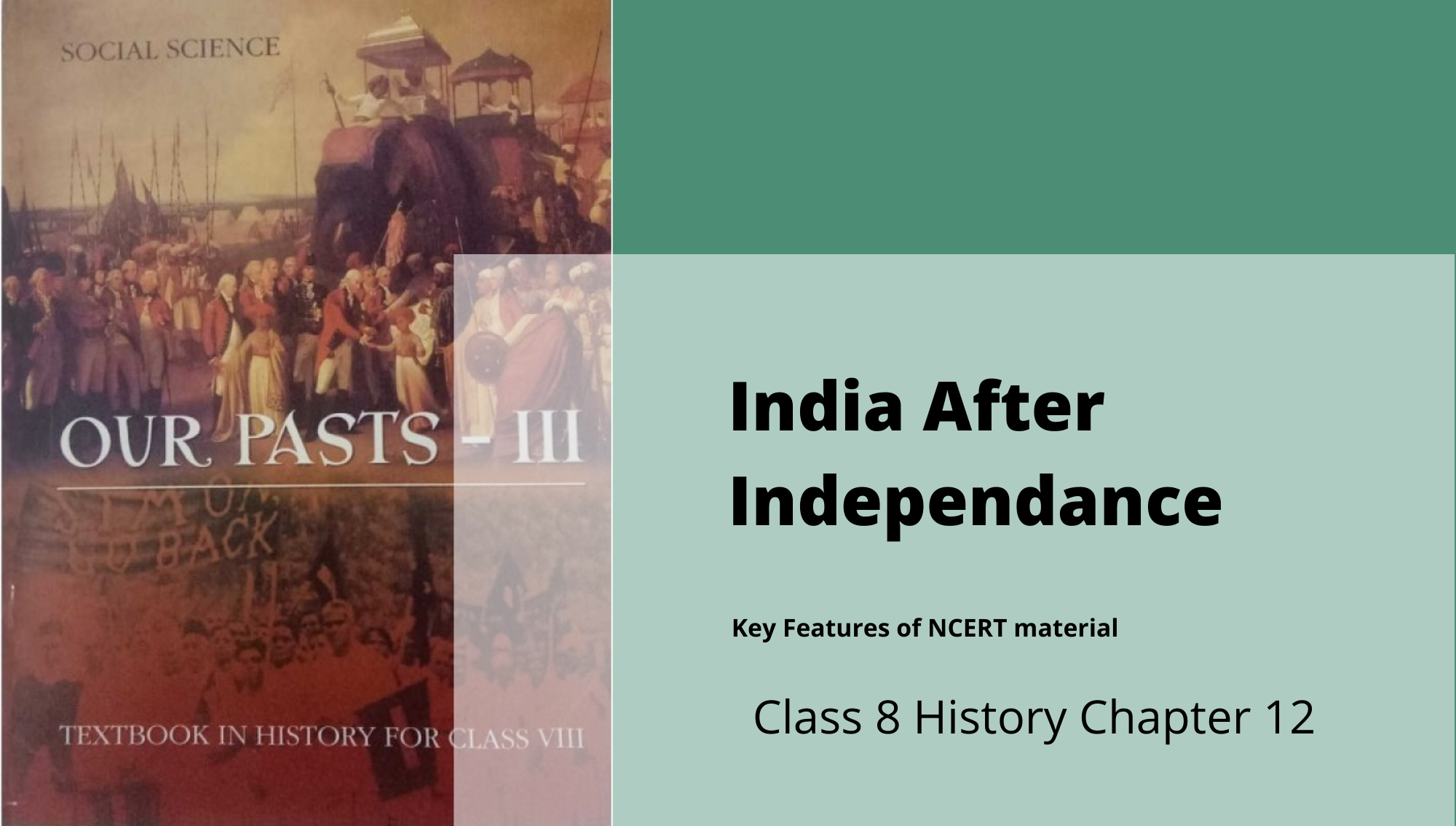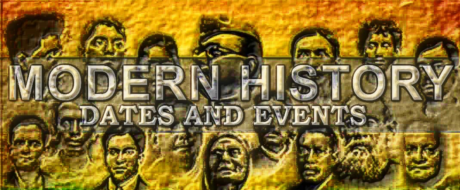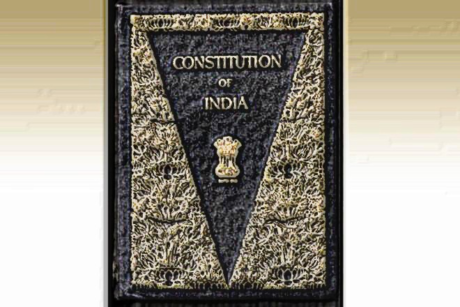India After Independence: Class 8 History

Key Features of NCERT Material for Class 8 History Chapter 12 – India After Independence
Quick revision notes
In Chapter 11 of Class 8 :The making of national movement , you must have learnt about movements in India. In chapter 12: India after independance, you will learn about india after 1947.
A New and Divided Nation
- Due to partition, 8 million refugees had come into India from what was now Pakistan.• There was about 500 princely states each ruled by a maharaja or a nawab, each of whom had to be persuaded to join the new nation.• There were divisions between high castes and low castes, between the majority Hindu community and Indians who practised other faiths.

A Constitution is Written
• Between December 1946 and November 1949, three hundred Indians had a series of meetings and decided on the formation of the Indian Constitution on 26 January, 1950.
• The features of Indian Constitution:
→ The adoption of universal adult franchise.
→ Guaranteed equality before the law to all citizens, regardless of their caste or religious affiliation.
→ Offered special constitutional rights to the poorest and the most disadvantaged Indian citizens along with the former Untouchables, the adivasis or Scheduled Tribes were also granted reservation in seats and jobs.
• The Constituent Assembly spent many days discussing the powers of the central government versus those of the state governments.
- The Constitution sought to balance claims by providing three lists of subjects:
→ Union List (subjects such as taxes, defence and foreign affairs): Centre
→ State List (subjects such as education and health): States
→ Concurrent List (subjects such as forests and agriculture): The Centre and the states
A Constitution was framed: Constitution is a composed archive, which spreads out the working of the legislature of the nation. The obligations and duties of the apparent multitude of organs of government are referenced in this report. In addition, the rights and obligations of the residents are likewise referenced in the constitution.
An enormous populace with assorted variety: the Indian populace at the hour of freedom was 345 million. The people followed various religions, communicated in various dialects and followed various societies. In this manner, numerous people thought that India would never join as a country. The issue of improvement was likewise appended to this.
Constituent Assembly: In request to outline the Constitution for India, Constituent Assembly was named. It had individuals from all pieces of the nation. It met between December 1946 and November 1949. Conversations and discussions were hung on various issues so as to outline the constitution which could be worthy by all.
Highlights of the Indian Constitution: Indian Constitution gave Universal Adult Franchise to every one of its residents over the endorsed age limit. Another element of the Indian Constitution was an arrangement of correspondence under the steady gaze of law. One significant element remembered for the Constitution was the arrangement of extraordinary benefits for poor and in reverse gatherings.

Force Sharing: Constituent Assembly spent numerous days in examining the issue of sharing of intensity between the focal government and the state governments. Conversations prompted the division of forces between the middle and states.
Public language: Many pioneers were of the view that Hindi ought to be perceived as the public language, yet pioneers of non-Hindi states contradicted this conclusion.
Conspicuous Leaders: B. R. Ambedkar was the director of the Drafting Committee. His obligation was to draft the constitution subsequent to assembling the reports of the apparent multitude of Committees.
The interest of the Linguistic States: Nationalist pioneers were hesitant to shape states based on dialects or religions, as a nation had just gone through the injury of segment. Potti Sriramullu went on hunger strike and passed on following 58 days of strike, which exacerbated the condition.
Getting ready for Development: In 1950, the Planning Commission was framed for structuring and executing reasonable arrangements for the monetary improvement of the nation. The blended economy model was picked for India.
Second Five-Year Plan: In 1956, the second five-year plan was defined. It laid weight on the advancement of the hefty ventures and working of dams.
The Nation following Sixty Years: On August fifteenth 2007, India commended its 60 years of autonomy. In its 60 years, India has stayed free and vote based system exists in India. In any case, divisions are as yet enduring in Indian culture. Shared brutality and position segregation despite everything exist in India.
Segment made various issues for free India.
Most importantly task was to restore the evacuees who had come into the nation from the recently conceived Pakistan.
At that point there was the issue of the regal states.
These two issues required a quick arrangement. Thereafter, the new country needed to embrace a political framework that would best serve the expectations and desires of its people.
The number of inhabitants in India in 1947 was around 345 million. One could watch a great deal of decent varieties in the nation with respect to dialects, nourishments, dresses, callings and so forth. There was wide hole between high standings and low positions. Regardless of every one of these decent varieties, people needed to live respectively in one country state. This made the issue of solidarity.
The issue of advancement was another significant point. Indian economy was frail at the time the nation got opportunity. Ranchers and laborers relied upon the rainstorm for their endurance.
In the urban areas, assembly line laborers lived in swarmed ghettos with little admittance to instruction or social insurance.
The new country needed to da a great deal of work so as to kill neediness, ignorance, and so forth. It needed to build efficiency of agribusiness and advance new, work making enterprises.
A composed constitution was basic for the nation. For this a progression of gatherings on the nation’s political future was held. Thus the Indian Constitution appeared on 26 January 1950.
The constitution embraced Universal Adult Franchise. All Indians over the age of 21 would be permitted to cast a ballot in state and public races. (Later it was decreased to 18′ years.)
Our constitution ensured balance under the steady gaze of the law to all residents, paying little mind to their station or strict association.
A third element of the constitution was that it offered exceptional benefits for the least fortunate and most burdened Indians. The act of distance was annulled. A specific level of seats in assemblies just as occupations in government was held for individuals from the least standings.
Alongside the previous untouchables, the advasis or Scheduled Tribes were additionally conceded reservation in seats and occupations. Like the Scheduled Castes, these Indians also had been denied and victimized.
So as to keep up balance between the focal government and that of the state governments, the constitution gave three arrangements of subjects—a Union List, with subjects, for example, charges, guard and international concerns, which would be sole obligation of the Center, a State List with subjects, for example, instruction and wellbeing, which would be dealt with basically by the states, a Concurrent List under which would come subjects, for example, backwoods and horticulture, in which both the inside and states would have joint duty.
The language was likewise a significant point. A few individuals from the Constituent Assembly needed to supplant English language with Hindi. Yet, non-Hindi speakers had distinctive supposition. They needed English language to be proceeded. Consequently, a trade off was at long last shown up at. It was settled that while Hindi would be the ‘official language’ of India, English would be utilized in the courts, the administrations and correspondence between one state and another.
Another serious issue was that of the arrangement of state. Both Prime Minister Nehru and Deputy Prime-Minister Vallabhbhai Patel were against the production of semantic states. Nehru unmistakably said that he needed to check disruptionist inclinations caused because of parcel and make the country solid and joined together.
This caused extraordinary frustration among the Kannada speakers, Malayalam speakers, the Marathi speakers and the Telugu speakers. They started to dissent. The most grounded fight originated from the Telugu-talking areas of the Madras Presidency.
In October 1952 a veteran Gandhian named Potti Sriramula went on a yearning quick requesting the development of Andhra state to secure the premiums of Telugu speakers. As the quick went on, it pulled in much help. Hartals and bandhs were seen in numerous towns.
At last, the new province of Andhra Pradesh appeared on 1 October, 1953.
Presently other semantic networks likewise started to request their own different states. A States Reorganization Commission was set up which presented its report in 1956, suggesting the redrawing of area and common limits to shape conservative regions of Assamese, Bengali, Oriya, Tamil, Malayalam, Kannada and Telugu speakers separately.
The huge Hindi-talking area of north India was separated into a few states.
In 1960, the bilingual territory of Bombay was partitioned into independent states for Marathi and Gujarati speakers.
In 1966, the territory of Punjab was additionally isolated into Punjab and Haryana.
Presently, anticipating advancement started to be made. Lifting India out of neediness and building an advanced specialized and modern base was ‘among the significant goals of the new country.
In 1950, the administration set up a Planning Commission to help structure and execute appropriate strategies for financial turn of events.
In 1956, the Second Five Year Plan was figured which centered emphatically gracious the advancement of weighty ventures.
62 years of autonomy have passed. This is definitely not a brief length. A ton has been accomplished in this time and yet, there have been various disappointments.
Success: India is as yet joined together and it is as yet fair.
- There is a free press.
- There is an autonomous legal executive.
- Solidarity in assorted variety.
Failures
- Profound divisions continue.
- In spite of established assurance, the Untouchables or the Dalits face brutality and separation.
- The inlet between the rich and the poor has developed over years.
Exile: An individual who has been driven away from his nation due to some political, social or strict reasons.
Establishment: The option to cast a ballot.
Phonetic: Relating to language.
State: Concerned with the legislature.
Non-arrangement: The strategy of not offering help for or accepting help from any of the amazing nations (USA and USSR) on the planet.
15 August 1947 – Indian got freedom.
30 January 1948 – Mahatma Gandhi was killed.
26 January 1950 – The Indian Constitution was received.
1 October 1953 – The new province of Andhra Pradesh appeared.
1960 – The bilingual state Bombay was isolated into independent states for Marathi and Gujarati speakers.
1966 – Punjab and East Patiala states association were partitioned into Punjab and Haryana.

